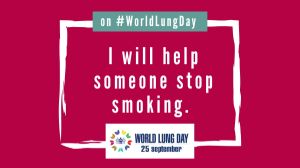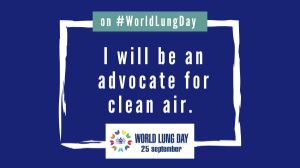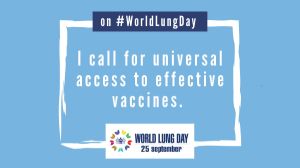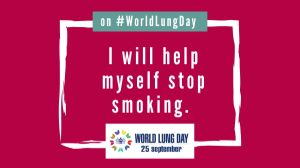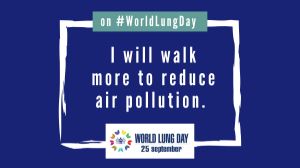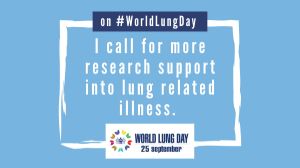World Lung Day

Prof Fong

Prof Welte
A recent editorial, "World Lung Day; What, Why and Where To?" by APSR Immediate Past President Prof. Kwun M Fong, MBBS, PhD, and ERS Past President Prof. Tobias Welte, MD, published in the American Journal of Physiology doi/abs/10.1152/ajplung.00364.2020 in recognition of the annual World Lung Day on 25 September 2020.
This editorial calls on researchers to support efforts to promote global lung health, and was written on behalf of the Forum of International Respiratory Societies (FIRS), of which the APSR is a founding member.
The following physiology journal articles are also now available:
- World health observances in September 2020: sepsis, the lung and heart, and pulmonary fibrosis in focus doi/full/10.1152/ajplung.00375.2020
- World Lung Day 2020 at the Journal of Applied Physiology and the American Journal of Physiology-Lung Cellular and Molecular Physiology doi/full/10.1152/ajplung.00371.2020
- Fostering the integration of basic respiratory science and translational pulmonary medicine for the future doi/full/10.1152/ajplung.00361.2020
- Diagnosing and treating lung disease at the cellular level doi/full/10.1152/ajplung.00372.2020
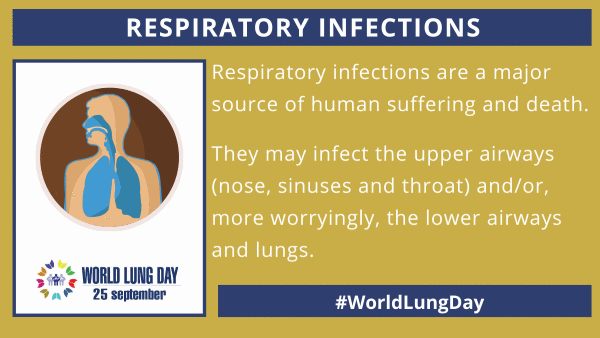
World Lung Day 2020: Respiratory Infections
In 2020, the coronavirus (COVID-19) pandemic has made the world aware of how deadly respiratory viruses can be as we together face the challenge of this novel coronavirus.
In reality, respiratory infections have been with us for a very long time and will continue to be a major source of human suffering and death. Apart from viruses, there are many other sources of respiratory infection that cause much human disease. These include bacteria, fungi and other organisms which may infect the upper airways (nose, sinuses and throat) and/or, more worryingly, the lower airways and lungs (such as bronchitis and or pneumonia).
They can cause lung symptoms such as cough, breathing difficulties, green sputum and breathlessness, as well as general symptoms such as fever, feeling ill and weight loss. Chest pain while breathing or coughing may also occur.
The burden of respiratory infections worldwide
Pneumonia
- Pneumonia is the leading cause of death in children and in the elderly.
- Each year almost 700,000 children die from pneumonia.
- Every minute, 2 children die from pneumonia.
- 80 percent of deaths are in children under 2 years and adults above 65 years.
- Almost all deaths occur in low and middle-income countries [1].
- Risk factors include age, smoking, chronic illnesses and conditions resulting in weakened immune systems.
Tuberculosis
- Each year there are 10 million new cases of tuberculosis (TB) and 1.5 million deaths.
- Deaths from TB occur mostly in children under 5 years and adults in the 20-35 year age range.
- Over 95 percent of TB deaths occur in low- and middle-income countries.
- TB is the main cause of death related to antimicrobial resistance and the leading killer of people with HIV. In 2017, 30 percent of HIV deaths were due to TB.
- Each day 4,383 people lose their lives to TB and 27,397 fall ill due to TB [2].
- Drug-resistant strains are becoming increasingly important and access to appropriate but expensive treatment is limited.
- By 2030 a five-year delay in investment in R&D for new TB tools would result in:
- 13.9 million additional people becoming sick with TB.
- 2 million additional TB deaths [3].
- Risk factors include people who have been recently infected with TB bacteria and people with chronic medical conditions that weaken the immune system.
COVID-19
- COVID-19 is currently a global pandemic, caused by a coronavirus.
- Viral respiratory infections can occur in epidemics and spread rapidly within communities across the globe, to become global pandemics.
- COVID-19 is one such viral respiratory infection that has affected more than 25 million people worldwide and nearly 860,000 have died by the beginning of September 2020. The burden is likely to increase exponentially in the near future [4].
- Older people, and those with underlying medical problems like high blood pressure, heart and lung problems, diabetes, or cancer, are at higher risk of developing serious illness with COVID-19. However, anyone can catch COVID-19 and become seriously ill.
Coronavirus (COVID-19)
In humans, several coronaviruses are known to cause respiratory infections ranging from the common cold to more severe diseases such as Middle East Respiratory Syndrome (MERS) and Severe Acute Respiratory Syndrome (SARS).
The most recently discovered coronavirus (SARS-CoV-2) causes coronavirus disease COVID-19. This new virus and disease were unknown before the outbreak began in Wuhan, China, in December 2019. COVID-19 is now a pandemic affecting many countries globally.
Is COVID-19 a respiratory infection?
Yes, COVID-19 is a respiratory infection. However, the virus can affect the whole body. It is the respiratory problems of breathlessness with low oxygen levels that are the commonest reason for going into hospital or needing intensive care.
What are the specific symptoms associated with COVID-19?
The most common symptoms of COVID-19 are fever, dry cough, shortness of breath and tiredness.
Other symptoms that are less common and may affect some patients include aches and pains, nasal congestion, headache, conjunctivitis, sore throat, diarrhoea, loss of taste or smell or a rash on skin or discoloration of fingers or toes. These symptoms are usually mild and begin gradually.
Some people become infected but only have very mild symptoms.
Most people (about 80 percent) recover from COVID-19 without hospital treatment. Around 1 out of every 5 people who gets COVID-19 becomes seriously ill and develops difficulty breathing. Perhaps 15 percent of those who recover have persistent symptoms [5].
Children are at much lower risk of getting severe COVID-19 – most childhood infections are mild or asymptomatic. A small number of children have developed an inflammatory condition.
Prevention
How do we prevent respiratory infections?
We can prevent many respiratory infections by vaccination. Vaccines for influenza, pneumococcal pneumonia, measles, tuberculosis (BCG reduces death and morbidity in young children from this disease) and whooping cough (Pertussis) are widely used.
Some infections ('flu', COVID-19) are spread by touching infected surfaces and then touching the nose or mouth. Hand washing is important.
Other infections are spread by breathing in the germ either from exposure to other patients who are coughing (such as tuberculosis, COVID-19) or from the air. Wearing a mask is highly effective to prevent transmission.
Some tropical infections are swallowed or enter through the skin and then find their way to the lung (worms). Again, washing hands before eating is important. Swimming is safer in chlorinated swimming pools and the sea compared to freshwater rivers, lakes or pools.
Maintain good health and nutrition to prevent getting infections – babies should be breastfed and adequate nutrition in childhood is crucial to prevent infections.
COVID-19 prevention advice
You can reduce your chances of being infected or spreading COVID-19 by taking some simple precautions; these are updated regularly by the World Health Organisation (WHO) and we should also follow our local government advice and regulations;
- Wear a mask. Wearing a mask is one of the most effective measures to prevent spread of the virus. Wear a mask especially in public places, at all times.
- Hand washing. Regularly and thoroughly clean your hands with an alcohol-based hand rub or wash them with soap and water. Why? Washing your hands with soap and water or using alcohol-based hand rub kills viruses that may be on your hands.
- Distance. Maintain the recommended physical distance (typically 2m) between yourself and others. Why? When someone coughs, sneezes, or speaks they spray small drops from their nose or mouth which may contain virus. If you are too close, you can breathe in the droplets, including the COVID-19 virus if the person has the disease.
- Avoid crowds. Avoid going to crowded places. Why? Where people come together in crowds, you are more likely to come into close contact with someone that has COVID-19 and it is more difficult to maintain physical distance.
- Avoid touching eyes, nose and mouth. Why? Hands touch many surfaces and can pick up viruses. Once contaminated, hands can transfer the virus to your eyes, nose or mouth. From there, the virus can enter your body and infect you.
- Good respiratory hygiene. Make sure you, and the people around you, follow good respiratory hygiene. This means covering your mouth and nose when you cough or sneeze with your bent elbow or tissue, which should be disposed of immediately followed by washing your hands. Why? Droplets spread virus. By following good respiratory hygiene, you protect the people around you from viruses such as cold, flu and COVID-19.
- Self-isolate. Stay home and self-isolate even with minor symptoms such as cough, headache, mild fever, until you recover or if you have had contact with someone who has COVID-19. Have someone bring you supplies. If you need to leave your house, wear a mask or covering in public as advised by your country. Why? Avoiding contact with others and wearing a mask will protect them from possible COVID-19 and other viruses.
Treatment
- Pneumonia. Pneumonia is treatable with antibiotics; oxygen may be needed for more severe pneumonia.
- TB. With a timely diagnosis and treatment with first-line antibiotics for 6 months, most people who develop TB can be cured and onward transmission of infection curtailed. Failure to take the full course of prescribed drugs appropriately may result in relapse with drug-resistant disease, which is more difficult to treat and poses a risk to others. For this reason, supervised or directly observed therapy is recommended as the standard of care to ensure adherence throughout the course of treatment.
- COVID-19. There's currently no specific treatment for COVID-19. Treatment aims to relieve the symptoms until you recover. Vaccines and treatment options are currently being investigated around the world.
In 2020, World Lung Day calls for research to prevent, detect and treat respiratory infections, particularly COVID-19 and TB
- Health security and prevention of future COVID-19 outbreaks.
- Predictive tests to show who is immune and who will develop disease from novel infections.
- Diagnostic tests to identify and treat those at risk to progress once infected.
- High quality randomised controlled trials to find the best vaccines and treatments.
- Access to effective, affordable vaccines and treatments for all.
- Educating all on the benefits and safety of the Influenza and Pneumococcal vaccines, as well as the COVID-19 vaccine once developed.
References
[1] FIRS: Forum of International Respiratory Societies. The Global Impact of Respiratory Disease – Second Edition. Sheffield, European Respiratory Society, 2017.
[2] Global Tuberculosis Report 2018, pub. World Health Organization: www.who.int/tb/publications/global_report/en
[3] Stop TB Partnership. The Paradigm Shift 2018-2022.
[4] John Hopkins University & Medicine. COVID-19 Dashboard (Online). coronavirus.jhu.edu/map.html, accessed 02.09.2020, 09:10.
[5] World Health Organization Q&A on coronaviruses (COVID-19) www.who.int/emergencies/diseases/novel-coronavirus-2019/question-and-answers-hub
Press release
World Lung Day 2020: Respiratory groups call for research to prevent, detect and treat respiratory infections
Tokyo, 25 September 2020
Today, on World Lung Day (WLD), the APSR is united with members of the Forum of International Respiratory Societies (FIRS) and WLD partner organisations to advocate for respiratory health globally and call for more research to prevent, detect and treat respiratory infections.
In 2020, the coronavirus (COVID-19) pandemic has made the world aware of how deadly respiratory viruses can be. In reality, respiratory infections have been with us for a very long time and will continue to be a major source of human suffering and death.
Apart from viruses, there are many other sources of respiratory infection that cause much human disease. These include bacteria, fungi and other organisms which may infect the upper airways (nose, sinuses and throat) and/or, more worryingly, the lower airways and lungs (such as bronchitis and or pneumonia).
They can cause lung symptoms such as cough, fast breathing, green sputum and breathlessness, as well as general symptoms such as fever, feeling ill and weight loss. Chest pain while breathing or coughing may also occur.
Respiratory infections impose an immense worldwide health burden:
- Each year almost 700,000 children die from pneumonia. 80 percent of deaths are in children under 2 years and adults above 65 years. Almost all deaths occur in low and middle-income countries.
- Each year there are 10 million new cases of tuberculosis (TB) and 1.5 million deaths. Deaths from TB occur mostly in children under 5 years and adults in the 20-35 year age range. Over 95 percent of TB deaths occur in low- and middle-income countries.
- Viral respiratory infections can occur in epidemics and spread rapidly within communities across the globe, to become global pandemics. COVID-19 is one such viral respiratory infection that has affected more than 25 million people worldwide and nearly 860,000 have died by the beginning of September 2020. The burden will continue to exponentially increase in the near future.
WLD is an annual lung health awareness day, occurring yearly on 25 September. To date nearly 200 organisations and many more individuals support WLD through lung heath advocacy and action. This year, with respiratory health firmly in the spotlight, it is a great opportunity to raise awareness of the burden of respiratory infections and call for:
- Health security and prevention of future COVID-19 outbreaks.
- Predictive tests to show who is immune and who will develop disease from novel infections.
- Diagnostic tests to identify and treat those at risk to progress once infected.
- High quality randomised controlled trials to find the best vaccines and treatments.
- Access to effective, affordable vaccines and treatments for all.
- Educating all on the benefits and safety of the Influenza and Pneumococcal vaccines, as well as the COVID-19 vaccine once developed.
To learn more about World Lung Day and download the fact sheet, graphics and pledge campaign go to the World Lung Day Toolkit.
About the Forum of International Respiratory Societies (FIRS)
Social Media Posts – World Lung Day 2020
Images for posts available in the WLD toolkit bit.ly/2YDTMuR
Tweets
We join @FIRS_LungsFirst on 25th September #WorldLungDay to advocate for respiratory health globally. Find out more and support the campaign here bit.ly/2YDTMuR
Join the #WorldLungDay campaign, shine a spotlight on lung health on 25th September bit.ly/2YDTMuR @FIRS_LungsFirst #LungHealth #RespiratoryInfections
Respiratory infections are a major source of human suffering and death. We need more research to prevent, detect and treat respiratory infections #WorldLungDay bit.ly/2YDTMuR @FIRS_LungsFirst
Every minute, 2 children die from #pneumonia - 80 percent of deaths are in children under 2 years and adults above 65 years. We need more research to prevent, detect and treat respiratory infections #WorldLungDay bit.ly/2YDTMuR @FIRS_LungsFirst
There are 10 million new cases of #TB and 1.5 million deaths each year. Over 95 percent of deaths are in low and middle-income countries. We need more research to prevent, detect and treat respiratory infections #WorldLungDay bit.ly/2YDTMuR @FIRS_LungsFirst
#COVID19 is a viral respiratory infection. So far it has affected 25 million people worldwide and nearly 860,000 have died. We need more research to prevent, detect and treat respiratory infections #WorldLungDay bit.ly/2YDTMuR @FIRS_LungsFirst
Vaccinations can prevent many respiratory infections #WorldLungDay bit.ly/2YDTMuR @FIRS_LungsFirst #LungHealth #RespiratoryInfections
Hand washing and wearing a mask can help stop the spread of respiratory infections #WorldLungDay bit.ly/2YDTMuR @FIRS_LungsFirst #LungHealth #RespiratoryInfections
On #WorldLungDay we call for research to prevent, detect and treat respiratory infections bit.ly/2YDTMuR @FIRS_LungsFirst #LungHealth #RespiratoryInfections
On #WorldLungDay we call for all people to have access to effective, affordable vaccines bit.ly/2YDTMuR @FIRS_LungsFirst #LungHealth #RespiratoryInfections #VaccinesForAll
On #WorldLungDay we calls for more education on the benefits and safety of vaccines bit.ly/2YDTMuR @FIRS_LungsFirst #LungHealth #RespiratoryInfections #VaccinesForAll
You can reduce your chances of being infected or spreading #COVID19 by taking some simple precautions #WorldLungDay bit.ly/2YDTMuR @FIRS_LungsFirst #LungHealth #RespiratoryInfections
Have you taken the #WorldLungDay pledge? Pledge to do something to improve lung health on World Lung Day, 25th September. Join the campaign and share your pledge bit.ly/2YDTMuR @FIRS_LungsFirst
I have taken the #WorldLungDay pledge. On World Lung Day, I will help someone stop smoking. Join the campaign and share your pledge bit.ly/2YDTMuR @FIRS_LungsFirst
I have taken the #WorldLungDay pledge. On World Lung Day, I will be an advocate for clean air. Join the campaign and share your pledge bit.ly/2YDTMuR @FIRS_LungsFirst
I have taken the #WorldLungDay pledge. On World Lung Day, I call for universal access to effective vaccines. Join the campaign and share your pledge bit.ly/2YDTMuR @FIRS_LungsFirst
I have taken the #WorldLungDay pledge. On World Lung Day, I will help myself stop smoking. Join the campaign and share your pledge bit.ly/2YDTMuR @FIRS_LungsFirst
I have taken the #WorldLungDay pledge. On World Lung Day, I will walk more to reduce air pollution. Join the campaign and share your pledge bit.ly/2YDTMuR @FIRS_LungsFirst
I have taken the #WorldLungDay pledge. On World Lung Day, I call for more research support into lung related illness. Join the campaign and share your pledge bit.ly/2YDTMuR @FIRS_LungsFirst
Facebook Posts
Sample Post 1
[insert your name] supports #WorldLungDay joining some 200 other organisations and individuals calling for lung heath advocacy and action on 25 September. Get involved and sign up bit.ly/2YDTMuR
Sample Post 2
Every minute, 2 children die from pneumonia.
80 percent of deaths are in children under 2 years and adults above 65 years.
Almost all deaths occur in low and middle-income countries.
We need more research to prevent, detect and treat respiratory infections.
Get involved and sign up bit.ly/2YDTMuR #WorldLungDay
Sample Post 3
There are 10 million new cases of TB and 1.5 million deaths each year.
Over 95 percent of deaths are in low and middle-income countries.
We need more research to prevent, detect and treat respiratory infections.
Get involved and sign up bit.ly/2YDTMuR #WorldLungDay
Sample Post 4
#COVID19 is a viral respiratory infection.
So far it has affected 25 million people worldwide and nearly 860,000 have died. We need more research to prevent, detect and treat respiratory infections #WorldLungDay bit.ly/2YDTMuR
Sample Post 5
Have you taken the #WorldLungDay pledge? Pledge to do something to improve lung health on World Lung Day, 25th September. Join the campaign and share your pledge bit.ly/2YDTMuR
About the Forum of International Respiratory Societies (FIRS)
The FIRS have prepared a series of fliers in different languages. Click any image to enlarge and copy for your use.
The PCCP celebrated World Lung Day by paying tribute to the modern heroes. Advocates of protecting the environment and making efforts to save our surroundings — Advocates of clean air for human health.
(You might need to zoom your screen to fully enjoy their video.)












